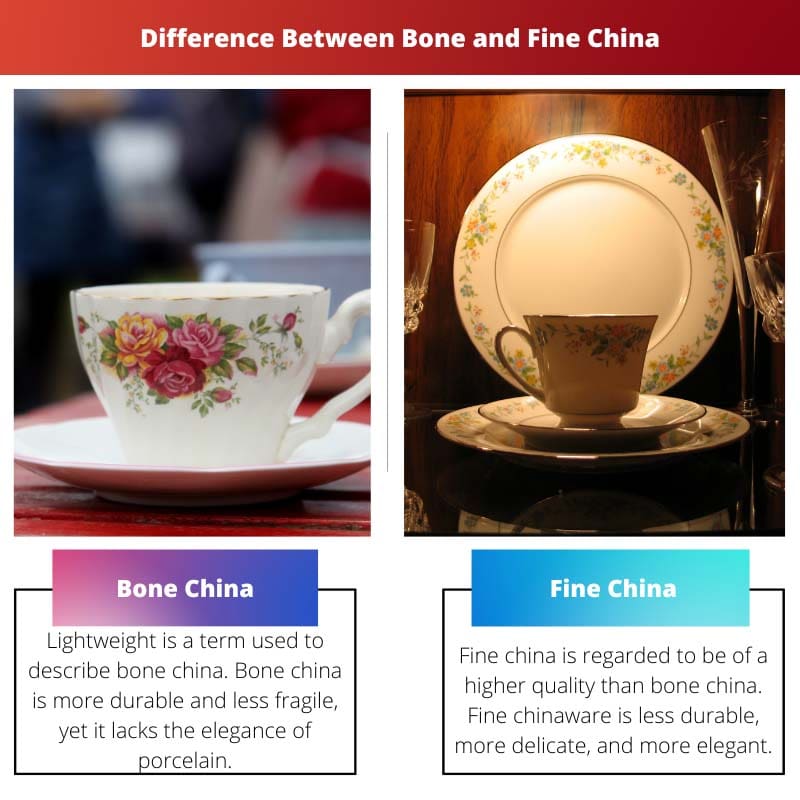Bone china was first introduced a couple of centuries ago, in the 1800s. The ceramic element, which contains china clay, bone ash, and china stone, is mixed with the cow Bone ash to make bone china.
Fine china was first introduced about the time of Christ (BC 11). Feldspar, clays, quartz, and kaolin are all used in the production of fine china. The base of fine china is thicker, giving it a brighter and whiter appearance.
Key Takeaways
- Bone china contains bone ash, giving it a unique translucent appearance, while fine china lacks bone ash and is slightly more opaque.
- Bone china is more expensive and considered a luxury item, while fine china is more affordable and widely used.
- Due to the bone ash content, bone china is stronger and more durable than fine china, making it less prone to chipping and breakage.
Bone vs Fine China
Bone China is a type of ceramic made of ‘bone ash’, which is ash made from animal bones mixed into the ceramic material. It is the highest quality ceramic with a smooth glaze used for tableware. Fine China is made with a combination of mixed clays, kaolin, feldspar, and quartz and is heavier.

The introduction of Bone china dates back a few centuries to the 1800s. Bone china is made by combining ceramic ingredients such as china clay, bone ash, and china stone with cow bone ash.
Bone china has a creamier, milky white, and softer appearance. It does, however, have a thinner, smoother foundation. Because bone chinaware is translucent, it lets a lot of light in. Bone china is a lightweight material.
The origins of excellent porcelain can be traced back to the time before Christ (BC 11). Feldspar, clays, quartz, and kaolin are used to make fine china. With a stronger foundation, fine china appears brighter and whiter.
Fine porcelain is opaque, allowing very little light to penetrate through. Fine china is a heavier weight than bone china. Fine porcelain is less durable, more fragile, and more elegant.
Comparison Table
| Parameters of Comparison | Bone China | Fine China |
|---|---|---|
| Price | Expensive | Less expensive |
| Weight | Lightweight | Comparatively heavy |
| Bone ash content | High | Low |
| Texture | Translucent | Opaque |
| Durability | More durable | Less durable |
What is Bone China?
Lightweight is a term used to describe bone china. Bone china is more durable and less fragile, yet it lacks the elegance of porcelain.
When two pieces of Bone china are smashed together, a “clang sound” is generated, which is comparable to the sound of a ringing bell. However, there is an echo.
The ceramic element, which contains china clay, bone ash, and china stone, is mixed with cow bone ash to make bone china. Bone china has a creamier, milkier white colour and is softer.
It does, however, have a thinner and smoother foundation. The Bone Chinaware has a higher percentage of bone ash.
Bone Chinaware has a highly crisp and smooth glaze. Bone china is incredibly expensive, and it is only available in limited quantities.
The advent of Bone china may be dated back several centuries, roughly to the 1800s. Because bone chinaware is translucent, it allows a significant amount of light to pass through.

What is Fine China?
Fine china is regarded to be of a higher quality than bone china. Fine chinaware is less durable, more delicate, and more elegant.
When two pieces of exquisite chinaware are smashed against one other, a “ding sound” is created that is quite loud but has no reverberation.
Feldspar, clays, quartz, and kaolin are mixed to make fine china. Fine china has a thicker foundation and a brighter, whiter appearance.
Fine chinaware is opaque, allowing very little light to penetrate through. Fine china is quite inexpensive, and it is not as pricey as bone china.
Fina chinaware has a rougher glaze than its Bone china counterpart. Furthermore, they are cost-effective. The amount of bona ash present in Fine china is lower. The origins of excellent porcelain can be traced back to before the birth of Christ (BC 11).

Main Differences Between Bone and Fine China
- The glaze of Bone Chinaware is very sharp and smooth. On the other hand, the glaze of Fina chinaware is less smooth as compared to its counterpart, which is Bone china.
- The price of bone china is very high. They come in an expensive price range. On the other hand, the price of fine china is comparatively low, and they are not as expensive as bone china. Moreover, these are even affordable.
- The presence of bone ash content in the Bone Chinaware is more. On the other hand, Bona ash content that is present in Fine china is less.
- The introduction of the Bone china can be traced back to a few centuries back, that is, around the 1800s. On the other hand, the introduction of the fine china can be traced back to Before Christ (BC 11).
- Bone china is prepared and manufactured by mixing the ceramic ingredient into the cow Bone ash, which includes china clay, bone ash and china stone. On the other hand, fine china is manufactured by the mixing up of feldspar, clays, quartz and kaolin.
- Bone china possesses a creamier, milky white and softer colour. However, it also possesses a thinner and smoother foundation. On the other hand, fine china possesses a brighter and whiter appearance with a thicker foundation.
- Bone chinaware being translucent allows a major portion of the light to pass through. On the other hand, Fine chinaware is opaque. Thus, hardly any light can pass through it.
- Bone china is considered to be lightweight. On the other hand, Fine china is considered to be a comparatively heavier weight than bone china.
- Bone china is more durable, less fragile, but less classy. On the other hand, fine chinaware is less durable, more fragile, but classy.
- When two pieces of Bone china are banged against each other, they produce a “clang sound”, which is similar to the sound produced by a ringing bell. However, echo is produced. On the other hand, when two pieces of fine chinaware are banged against each other, they produce a “ding sound”, which is quite intense but with no echo.
